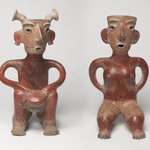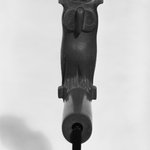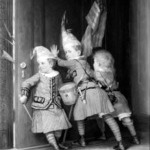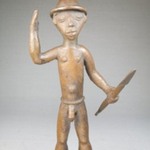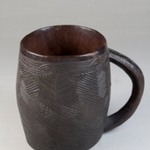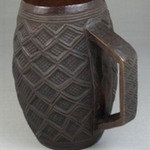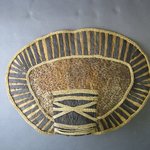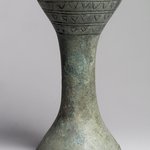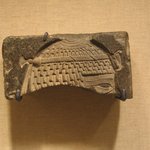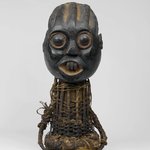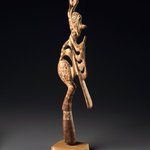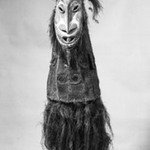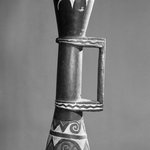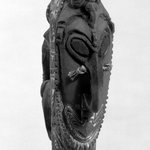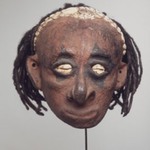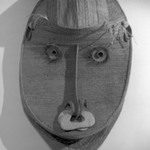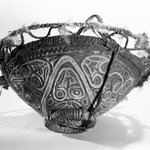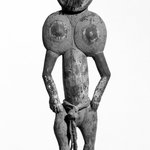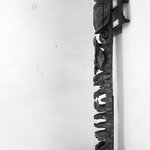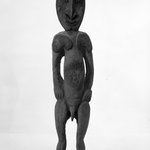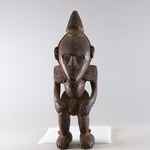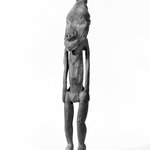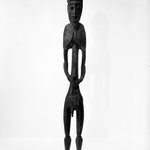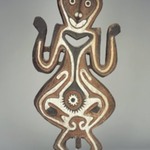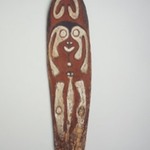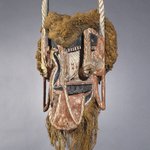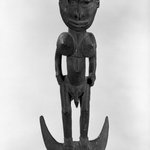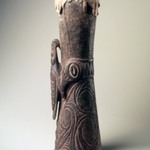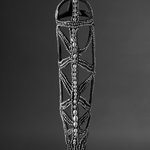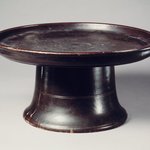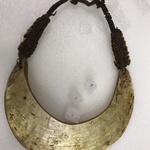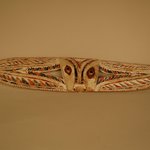

Iatmul. Drum, early 20th century. Wood, shell, pigment, 26 1/4 x 7 1/2 x 9 in. (66.7 x 19.1 x 22.9 cm). Brooklyn Museum, Gift of Marcia and John Friede and Mrs. Melville W. Hall, 87.218.70a-b. Creative Commons-BY (Photo: Brooklyn Museum, 87.218.70_SL1.jpg)
Drum
Arts of the Pacific Islands
The lower portion of this drum is decorated with relief carvings of spirals and concentric arcs that were originally painted white and red. The large face, with its projecting tongue, is meant to be threatening, indicating the power of the clan that owned it. Above and below the face are two cassowary birds.
This drum is closely related to three other published examples, which all may be by the same artist. All were collected at the beginning of the twentieth century. The design is reportedly that of a Chambri drum captured by the Iatmul people and then used to celebrate their victory. This type of drum, which originally had a membrane covering the top, provides accompaniment for clan songs on ceremonial occasions such as funerals, the launching of new canoes, or the completion of a clan house.
This drum is closely related to three other published examples, which all may be by the same artist. All were collected at the beginning of the twentieth century. The design is reportedly that of a Chambri drum captured by the Iatmul people and then used to celebrate their victory. This type of drum, which originally had a membrane covering the top, provides accompaniment for clan songs on ceremonial occasions such as funerals, the launching of new canoes, or the completion of a clan house.
CULTURE
Iatmul
MEDIUM
Wood, shell, pigment
DATES
early 20th century
DIMENSIONS
26 1/4 x 7 1/2 x 9 in. (66.7 x 19.1 x 22.9 cm) (show scale)
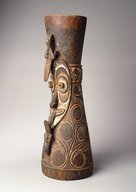


COLLECTIONS
Arts of the Pacific Islands
ACCESSION NUMBER
87.218.70a-b
CREDIT LINE
Gift of Marcia and John Friede and Mrs. Melville W. Hall
CATALOGUE DESCRIPTION
Wood drum in form of a hollow hourglass. Upper third, plain; remaining section carved with fine decoration including swirls and borders of zigzag patterns. Front, central concave area has face in high relief. Face has cylindrical eyes with shell insets, elongated nose, and broad mouth. Mouth has a long tongue hanging down under upturned outward-pointing tail feathers of a symmetrical bird. Head of a second bird begins above face with upturned tail feathers extending out over forehead to bridge of nose between eyes. Overall surface is rough and black; crevices are filled with white and light orange pigment.
From catalogue card:
Wooden drum. Hollow hourglass form with finely carved embellishment on lower 2/3 of exterior surface. In high relief, a concave face terminates at each end by a bird, with shell eyes. S-volute design pattern delimited by zigzag border at bottom. White and light orange pigment fills crevices and contrasts with rough, blackened surface.
Condition: Thin longitudinal crack below proper left eye; another crack on proper left side; two more, very small, from bottom in back. Large and small cracks from bottom upward on proper right side. Sections chipped off of both eyes and another chip lower proper left eye. Abrasions around entire rim.
EXHIBITIONS
MUSEUM LOCATION
This item is not on view
CAPTION
Iatmul. Drum, early 20th century. Wood, shell, pigment, 26 1/4 x 7 1/2 x 9 in. (66.7 x 19.1 x 22.9 cm). Brooklyn Museum, Gift of Marcia and John Friede and Mrs. Melville W. Hall, 87.218.70a-b. Creative Commons-BY (Photo: Brooklyn Museum, 87.218.70_SL1.jpg)
IMAGE
overall, 87.218.70_SL1.jpg. Brooklyn Museum photograph
"CUR" at the beginning of an image file name means that the image was created by a curatorial staff member. These study images may be digital point-and-shoot photographs, when we don\'t yet have high-quality studio photography, or they may be scans of older negatives, slides, or photographic prints, providing historical documentation of the object.
RIGHTS STATEMENT
Creative Commons-BY
You may download and use Brooklyn Museum images of this three-dimensional work in accordance with a Creative Commons license. Fair use, as understood under the United States Copyright Act, may also apply.
Please include caption information from this page and credit the Brooklyn Museum. If you need a high resolution file, please fill out our online application form (charges apply).
For further information about copyright, we recommend resources at the United States Library of Congress, Cornell University, Copyright and Cultural Institutions: Guidelines for U.S. Libraries, Archives, and Museums, and Copyright Watch.
For more information about the Museum's rights project, including how rights types are assigned, please see our blog posts on copyright.
If you have any information regarding this work and rights to it, please contact copyright@brooklynmuseum.org.
RECORD COMPLETENESS
Not every record you will find here is complete. More information is available for some works than for others, and some entries have been updated more recently. Records are frequently reviewed and revised, and we welcome any additional information you might have.



